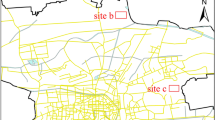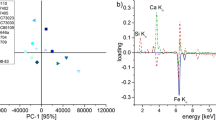Abstract
The relationship between the mortality of leukemia and the contents of trace elements in the soils of 29 regions of China was investigated. A total of 27 elements were determined for each region. Considering that an efficient variable selection can be highly beneficial both to improve the predictive ability of the model and to greatly reduce its complexity, genetic algorithm–partial least squares was used to screen out 13 qualified elements. As a result, only 13 elements, i.e., As, Hg, Mn, Sr, Ba, Cu, Ti, Co, K, Ca, Rb, Zn, and Mg, were picked out and, a partial least squares model with three latent variables was obtained, whose prediction exhibited a correlative coefficient of 0.874 with actual mortality. Especially, it showed a high negative correlation between the content of soil As and the mortality of leukemia. Such a fact can be explained by the apoptotic effect of cancerous cells by trace-amount arsenic trioxide. Furthermore, according to whether the mortality was larger than two out of 100,000 (2 × 10−5), all the 29 regions were divided into 21 high-mortality regions and eight low-mortality regions and were assigned the label −1 or 1, respectively. Using the same 13 elements, a Fisher's discriminant analysis model was developed, which can successfully discriminate low- and high-mortality groups.






Similar content being viewed by others
References
Ebrahim AM, Eltayeb MAH, Shaat MK, Mohmed NMA, Eltayeb EA, Ahmed AY (2007) Study of selected trace elements in cancerous and non-cancerous human breast tissues from Sudanese subjects using instrumental neutron activation analysis. Sci Total Environ 383:52–58
Feldman EB (1993) Dietary intervention and chemoprevention—1992 perspective. Prev Med 22:661–666
Bowen P (2000) Dietary intervention strategies: validity, execution and interpretation of outcomes in nutrition and cancer prevention. Kluwer, Dordrecht
Clemens MR (1991) Free radicals in chemical carcinogenesis. J Mol Med 69:1123–1134
Weinstein IB (1988) The origins of human cancer. Cancer Res 48:4135–4143
Zhang ZY, Zhou HL, Liu SD, Harrington PB (2001) Classification of cancer patients based on elemental contents of serums using bidirectional associative memory networks. Anal Chim Acta 436:281–291
Ren YL, Zhang ZY, Ren YQ, Li W, Wang MC, Xu G (1997) Diagnosis of lung cancer based on metal contents in serum and hair using multivariate statistical methods. Talanta 44:1823–1831
Chan S, Gerson B, Subramaniam S (1998) The role of copper, molybdenum, selenium, and zinc in nutrition and health. Clin Lab Med 18:673–685
Douglas MT (2003) The importance of trace element speciation in biomedical science. Anal Bioanal Chem 375:1062–1066
HegdeP SML, Vengamma B, Rao TSS, Menon RB, Rao RV, Rao KSJ (2004) Serum trace element levels and the complexity of inter-element relations in patients with Parkinson's disease. J Trace Elem Med Biol 18:163–171
Forte G, Alimonti A, Violante N, Gregorio M, Senofonte O, Petrucci F, Sancesario G, Bocca B (2005) Calcium, copper, iron, magnesium, silicon and zinc content of hair in Parkinson's disease. J Trace Elem Med Biol 19:195–201
Tan C, Chen H, Xia CY (2009) Early prediction of lung cancer based on the combination of trace element analysis in urine and an Adaboost algorithm. J Pharm Biomed Anal 49:746–752
Kuo HS, Chen SF, Wu CC, Chen DR, Lee JH (2002) Serum and tissue trace elements in patients with breast cancer in Taiwan. Biol Trace Elem Res 89:1–11
Tan C, Chen H, Xia CY (2009) The prediction of cardiovascular disease based on trace element contents in hair and a classifier of boosting decision stumps. Biol Trace Elem Res 129:9–19
Zhang ZY, Zhou HL, Liu SD, Harrington P (2006) An application of Takagi–Sugeno fuzzy system to the classification of cancer patients based on elemental contents in serum samples. Chemometr Intell Lab Syst 82:294–299
Gurusamy K, Davidson BR (2007) Trace element concentration in metastatic liver disease—a systematic review. J Trace Elem Med Biol 21:169–177
Sattar N, Scott HR, McMillan DC, Talwar D, O'Reilly DS, Fell GS (1997) Acute-phase reactants and plasma trace element concentrations in non-small cell lung cancer patients and controls. Nutr Cancer 28:308–312
Leung PL, Huang HM (1997) Analysis of trace elements in the hair of volunteers suffering from naso-pharyngeal cancer. Biol Trace Elem Res 57:19–25
Brown CJ, Chenery SR, Smith B, Mason C, Tomkins A, Roberts GJ, Sserunjogi L, Tiberindwa JV (2004) Environmental influences on the trace element content of teeth—implications for disease and nutritional status. Arch Oral Biol 49:705–717
Steiner DM, Steiner GG (2004) Fluoride as an essential element in the prevention of disease. Med Hypotheses 62:710–717
Zhai HL, Chen XG, Hu ZD (2003) Study on the relationship between intake of trace elements and breast cancer mortality with chemometric methods. Comput Biol Chem 27:581–586
Shtangeeva I, Kulikov V (1995) Study of chemical element behaviour in health and disease by means of neutron activation analysis and multivariate statistics. Nutrition 11:592–594
Smith M, Chen T, Simon R (1997) Age-specific incidence of acute lymphoblastic leukemia in U.S. children: in utero initiation model. J Natl Cancer Inst 89:1542–1544
Kwiatek WM, Banas A, Banas K, Gajda M, Galka M, Falkenberg G, Cichocki K (2005) Iron and other elements studies in cancerous and non cancerous prostate tissues. J Alloys Compd 401:178–183
Zowczak M, Iskra M, Paszkowski J, Maflczak M, TorLiflski L, Wysocka EJ (2001) Oxidase activity of ceruloplasmin and concentrations of copper and zinc in serum of cancer patients. J Trace Elem Med Biol 15:193–196
El-Bayoumy K (2000) The protective role of Se on genetic damage and on cancer. Mutat Res 475(1–2):123–139
Ishigame K, Nishi Y (1985) Superoxide dismutase activity and zinc, copper, and manganese concentrations in leukocytes. Clin Chem 31(6):1094–1095
Zuo XL, Chen JM, Zhou X, Li XZ, Mei GY (2006) Levels of selenium, zinc, copper, and antioxidant enzyme activity in patients with leukemia. Biol Trace Elem Res 114:41–53
Lavine BK, Davidson CE, Moores AJ (2002) Genetic algorithms for spectral pattern recognition. Vib Spectros 28:83–95
Leardi R, Boggia R, Terrile M (1992) Genetic algorithms as a strategy for feature selection. J Chemom 6:267–281
Leardi R (1996) Genetic algorithms as a strategy in feature selection. In: Devillers J (ed) Genetic algorithms in molecular modeling. Academic, New York, p 67
Sjöström M, Wold S, Lindberg W, Persson JA, Martens H (1983) A multivariate calibration problem in analytical chemistry solved by partial least-squares models in latent variables. Anal Chim Acta 150:61–70
Wold S, Sjöström M, Eriksson L (2001) PLS-regression: a basic tool of chemometrics. Chemometr Intell Lab Syst 58:109–130
Leardi R, González AL (1998) Genetic algorithms applied to feature selection in PLS regression: how and when to use them. Chemometr Intell Lab Syst 41:195–207
Chiang LH, Kotanchek ME, Kordon AK (2004) Fault diagnosis based on Fisher discriminant analysis and support vector machines. Comput Chem Eng 28:1389–1401
China National Environmental Monitoring Center (1990) The background concentrations of soil elements in China. China Environmental Science Press, Beijing
Wei HL, Su HX, Bai DC, Zhao HS, Ge JG, Wang B, Yao XJ, Ma LF (2003) Arsenic trioxide inhibits p-glycoprotein expression in multidrug-resistant human leukemia cells that overexpress the MDR1 gene. Chin Med J 116:1644–1648
Acknowledgements
This work was supported by the Sichuan Province Science Foundation for Youths (09ZQ026-066) and the Scientific Research Startup Fund for Doctors, Yibin University (2008B06).
Author information
Authors and Affiliations
Corresponding author
Rights and permissions
About this article
Cite this article
Tan, C., Chen, H. & Xia, C. Analysis of the Relationship Between Leukemia Mortality and Soil Trace Elements using Chemometrics. Biol Trace Elem Res 137, 289–300 (2010). https://doi.org/10.1007/s12011-009-8582-8
Received:
Accepted:
Published:
Issue Date:
DOI: https://doi.org/10.1007/s12011-009-8582-8




